By Fr. Devin Roza
I’m very excited that the Liturgy of the Hours has made it to Verbum! And in this blog post, I’d like to share with you a few ideas about how you can use the Liturgy of the Hours in Verbum to study our faith.
The Liturgy of the Hours is the official prayer of the Church and is prayed every day by priests, religious and laity around the world. And the liturgy isn’t just any prayer! The Catechism of the Catholic Church explains that “liturgy is a constituent element of the holy and living Tradition.” The liturgy, then, also is one of the ways we learn, transmit and live our faith.
This theological truth was summed up by Prosper of Aquitine in the 5th century when he said that “the law of prayer establishes the law of faith.” Theologians have condensed this idea in the Latin phrase lex orandi, lex credendi: “the law of prayer is the law of faith” (CCC 1124). As St. Irenaeus put it already in the 2nd century, “Our way of thinking is attuned to the Eucharist, and the Eucharist in turn confirms our way of thinking” (Against Heresies, IV, 18, 5, cited in CCC 1327).
So, if we want to study the faith that has been handed down to us from the apostles, one of the ways we can do so is by studying the liturgy. And with its many readings from the Church Fathers, Councils, and saints, the Liturgy of the Hours is a particularly privileged place to study our faith!
To give an example, one of my favorite readings is the one from Good Friday. In it, St. John Chrysostom, who was named bishop of Constantinople in 397, explains how Christ’s sacrifice on the cross was prefigured by the Passover Lamb:
If we wish to understand the power of Christ’s blood, we should go back to the ancient account of its prefiguration in Egypt. Sacrifice a lamb without blemish, commanded Moses, and sprinkle its blood on your doors. If we were to ask him what he meant, and how the blood of an irrational beast could possibly save men endowed with reason, his answer would be that the saving power lies not in the blood itself, but in the fact that it is a sign of the Lord’s blood. In those days, when the destroying angel saw the blood on the doors he did not dare to enter, so how much less will the devil approach now when he sees, not that figurative blood on the doors, but the true blood on the lips of believers, the doors of the temple of Christ.
What a powerful image of what it means to receive Christ in the Eucharist! If the ancient angel “passed over” those doors which had been sprinkled in the blood of the Passover Lamb, how much more would the angel of death now “pass over” those believers who have the blood of Christ, the true Passover Lamb, on their lips, “the doors of the temple of Christ.”
This is just one example of the richness of our faith which the Liturgy of the Hours makes available to us! To help begin unlocking some of this richness, here are 4 tips to study the faith with the Liturgy of the Hours.
Add the Liturgy of the Hours to your Lectionary Layout
Verbum has a great Lectionary Layout, that allows you to study readings of the day, together with the prayers from the Mass of the day. You can also add the Liturgy of the Hours to the default Lectionary layout, and Verbum will open it to whatever date you selected. This can be a great way to remember to read the 2nd reading from the Office of Readings, which is an especially fruitful way to study the Liturgy of the Hours. Let’s see how!
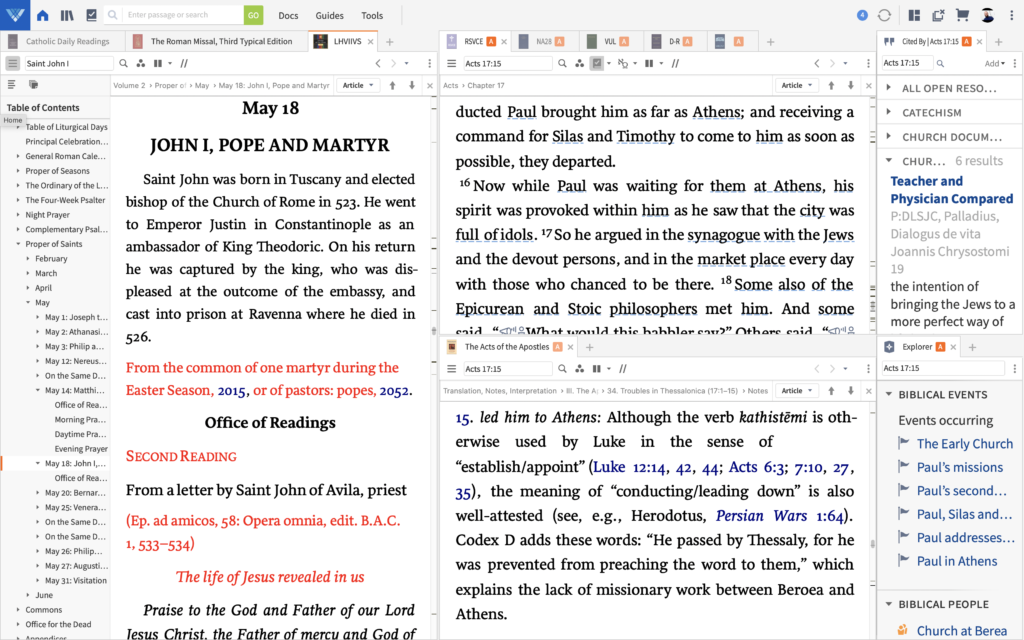
To open the Lectionary Layout, the easiest way is from the Home Page, using a Lectionary card, which allows you to select the date (make sure you have all resources closed before clicking on the card, or it will only open the Lectionary, not the entire layout!):
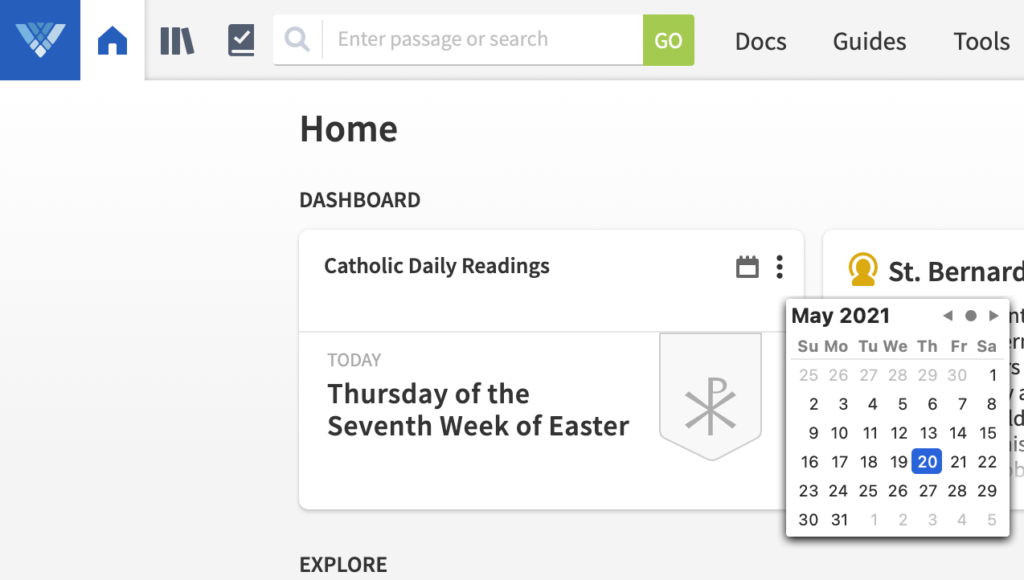
Now, add the Liturgy of the Hours to the Layout that was opened. Place it wherever you would like it, and feel free to make any other changes you would like! Finally, activate the tabs that you would prefer to be selected by default.
You’re now ready to save your updated layout! To do so, open the Layouts menu, and under the section called “Home Page Layouts”, click on the arrow to the right of “Lectionary”, and choose “Replace with current layout.” Verbum will indicate that you have customized this layout by adding the word “Custom” in grey:
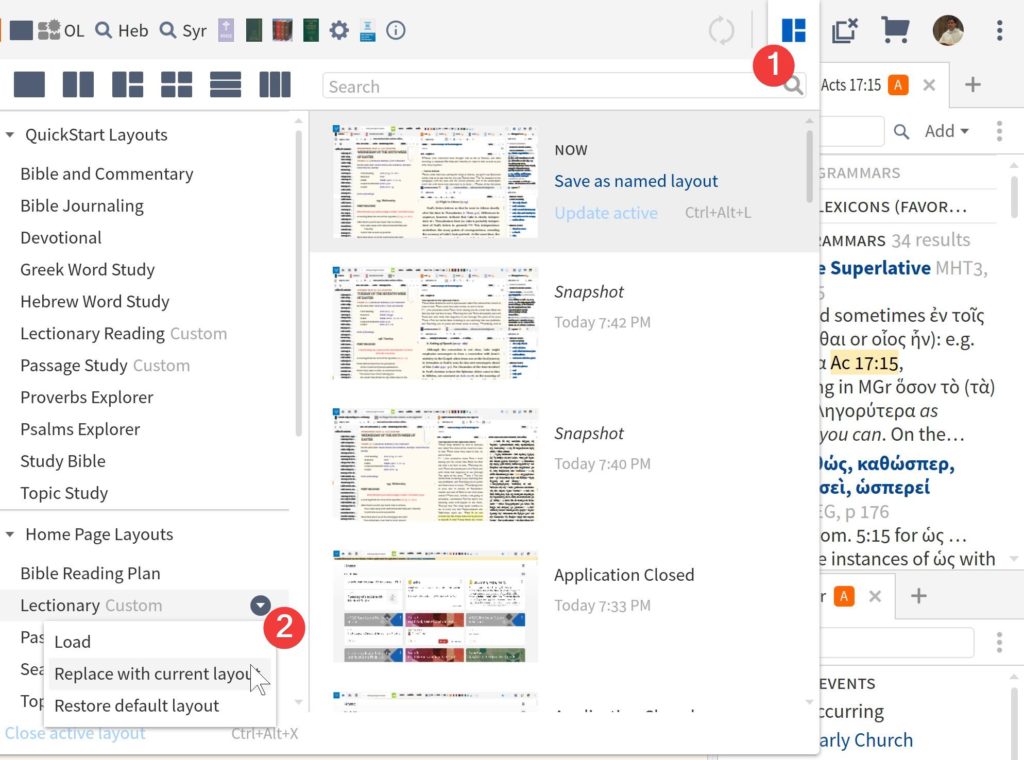
The next time you open the Lectionary Layout from the Home Page, Verbum will remember that you had added the Liturgy of the Hours. Not only will it include it, but it will open it up to whatever date you have selected from the Home Page!
Feel free to customize the Lectionary Layout as much as you like! And no worries – you can always go back to the default layout by choosing “Restore default layout.”
Use the Today button
Even without the Lectionary Layout, you can always navigate to “Today” in the Liturgy of the Hours. To do so, open the sidebar by clicking on the hamburger icon, and scroll up to the top of the table of contents. Click on Today, and the Liturgy of the Hours will navigate to today’s Liturgy!
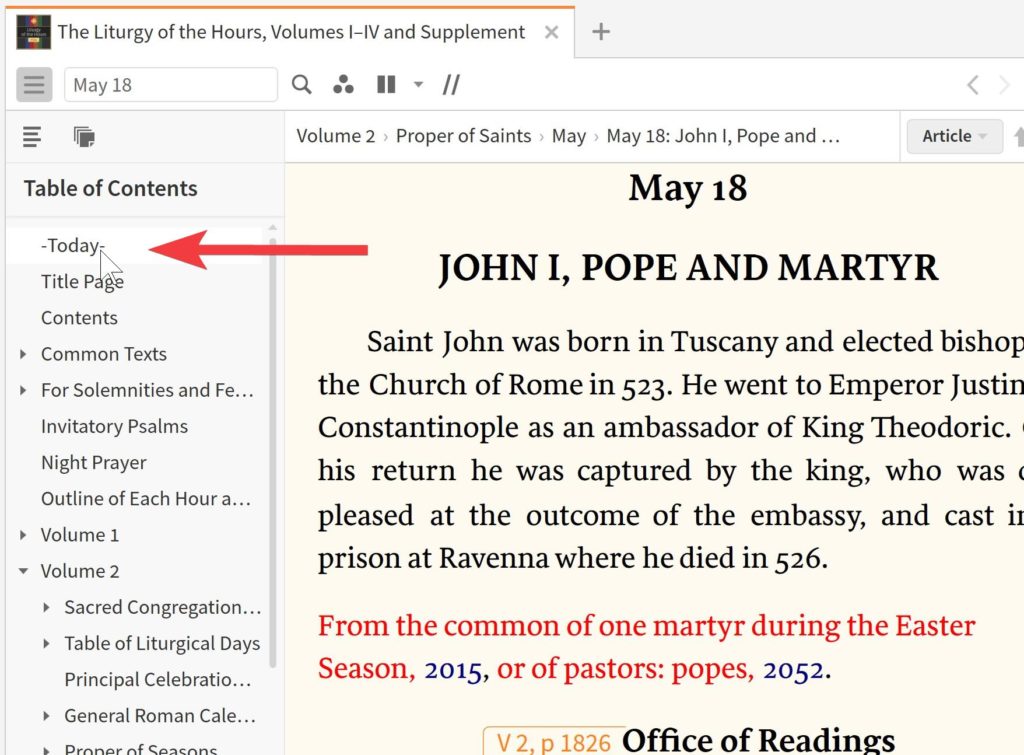
Search for topics within the Liturgy of the Hours
We saw how St. John Chrysostom explained how Jesus’s sacrifice on the cross, and the Eucharist, were prefigured by the Passover Lamb. What if I want to see what else the Liturgy has to say about the Passover? In Verbum this is simple, with search.
I could begin by running an Inline Search for “Passover”. To do so, click on the Inline Search button (the magnifying glass), type in Passover, and press Enter.
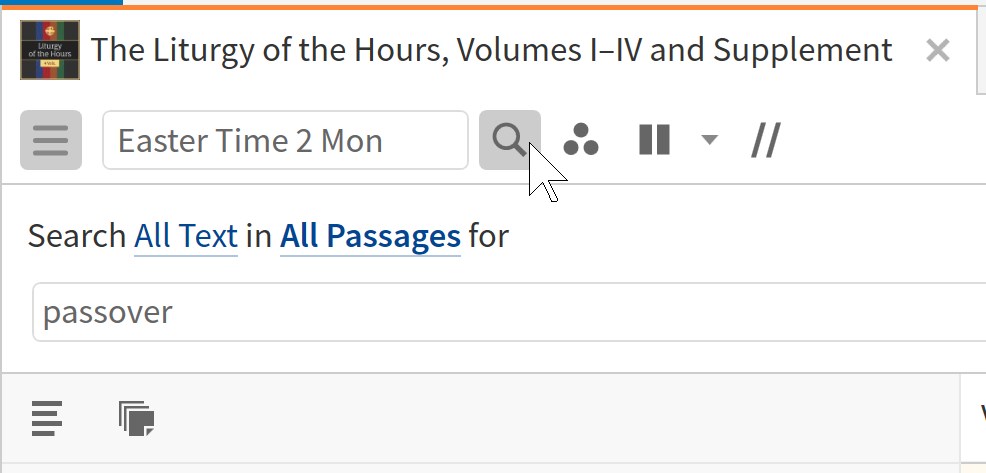
Verbum returns 57 times where the word Passover appears. A text from St. Gaudentius of Brescia (4th century) quickly catches my attention:
And so, now that you have escaped from the power of Egypt and of Pharaoh, who is the devil, join with us, all of you, in receiving this sacrifice of the saving passover with the eagerness of dedicated hearts. Then in our inmost being we shall be wholly sanctified by the very Lord Jesus Christ whom we believe to be present in his sacraments, and whose boundless power abides for ever.
St. Gaudentius is speaking to the newly baptized, who will be able to receive Christ in the Eucharist for the first time, after having “escaped from the power of Egypt and of Pharaoh, who is the devil” through baptism.
If you will be doing a lot of searches inside the Liturgy of the Hours, open a dedicated search panel, and place it next to the Liturgy of the Hours. This will allow you to better see the context of your search results! For example, a search for blood NEAR side quickly allowed me to find this text by St. Andrew of Crete, from the feast of the Triumph of the Cross.
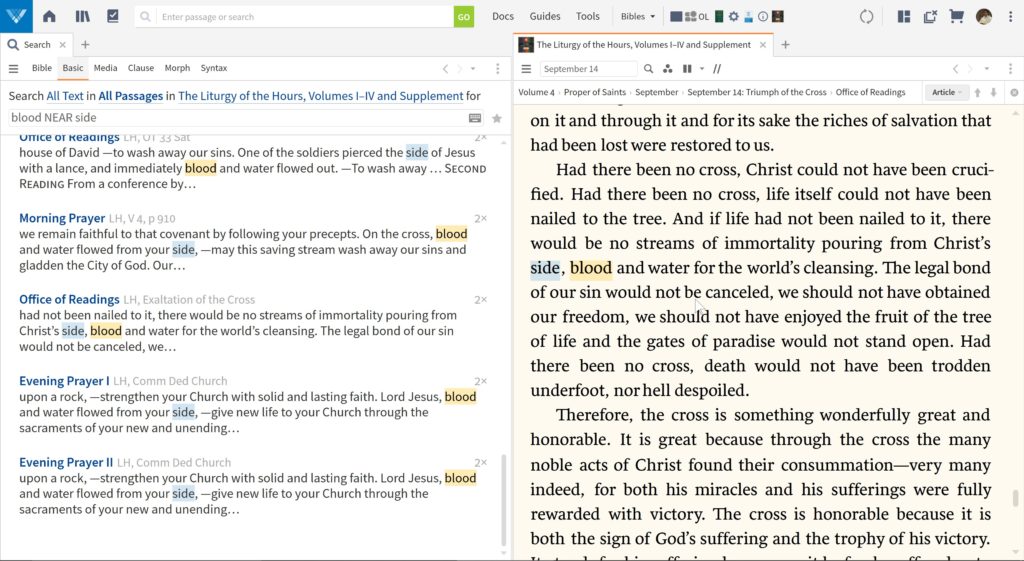
Use Fulfilled in Christ: The Sacraments
One final tip. I wrote the book Fulfilled in Christ: The Sacraments as a guide to the prefigurations and symbols of the sacraments that are found in the Bible, the Catechism, and in the Liturgy, including the Liturgy of the Hours! It contains over 1000 references to the Liturgy of the Hours already classified and organized, including the readings from the Church Fathers and saints. If you’re curious about what the liturgy of our faith has to say about how the Manna in the desert prefigured the Eucharist, or how Nathan’s forgiveness of David is seen as prefiguring the sacrament of confession, or dozens of other types and symbols of the sacraments, this book is for you! (Note that Verbum is still implementing the hyperlinking between Fulfilled in Christ and the Liturgy of the Hours, so in the future this resource will be even more useful, but even now it can be useful as an index of topics and readings in the Liturgy of the Hours).
Conclusion
I’m convinced that the liturgy is an important path that God offers us to deepen in our faith and in our understanding of the Tradition handed down to us from the apostles. I’m very excited that the Liturgy of the Hours is now available in Verbum; there is no other platform where the liturgy can be studied as easily and as fruitfully.
Fr. Devin Roza taught as adjunct professor at the Pontifical Athenaeum Regina Apostolorum from 2016-2020. He is currently a doctoral student in Sacred Scripture at the Pontifical Biblical Institute. He is the author of Fulfilled in Christ: The Sacraments. A Guide to Symbols and Types in the Bible and Tradition.

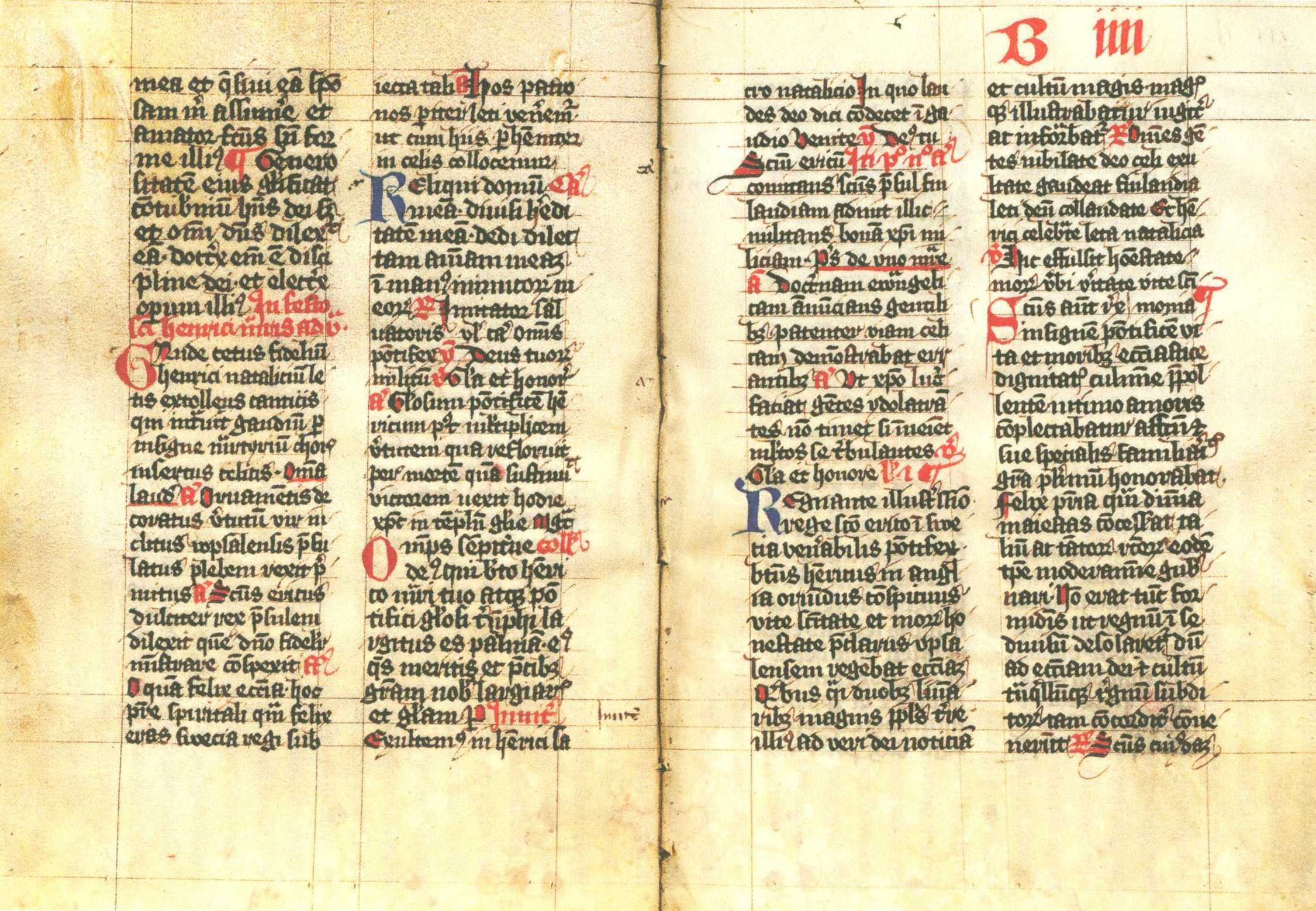
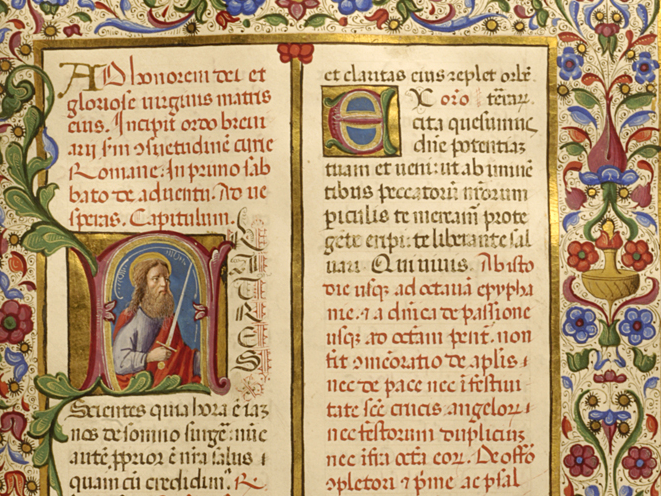
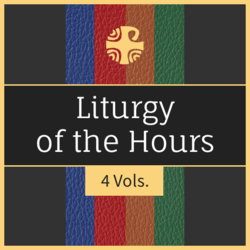
Thank you Father Devin. Please help in this –
“Use the Today button
Even without the Lectionary Layout, you can always navigate to “Today” in the Liturgy of the Hours. To do so, open the sidebar by clicking on the hamburger icon, and scroll up to the top of the table of contents. Click on Today, and the Liturgy of the Hours will navigate to today’s Liturgy! “
The Today Button does provide any results on either my 16 Gig Mac mini M1, my 8 Gig MacBook Pro M1, or my 16 Gig Intel i7 Windows 10 HP Envy.
And If I enter today’s date June 12 (Memorial of the Immaculate Heart of the Blessed Virgin Mary), (using “Month, Day” ordering because using “Day, Month” format doesn’t work), nothing is returned for the dates of June 4, 7, 8, 10, 12, 14, 15, 16, 17, 18, 20, 23, 25, 26. So for 47% of June, the LotH Verbum resource provides no template for praying the DO.
How am I to learn to follow this? Can’t someone provide a roadmap for these days of the LotH, so that a newbie can follow it and learn it?
Pax Christi
The “Today” button remains a work in progress. Currently it works for 233 days of the year.
[…] addition to being one of the public prayers of the Church and an important tool to study the Faith, the Liturgy of the Hours is a treasury of Christian poetry. The poems are collected in the fourth […]
My Liturgy of the Hours does not appear as an option in the Lectionary card. I get a host of different options, from the Catholic Daily Readings to three Byzantine lectionaries to the Book of Common Prayer, but the LOTH does not show up, even though I bought it and can browse it manually. Please advise!
Hi Eric,
You can select a date in the lectionary card, but to bring in Liturgy of the Hours you have to manually drag it into the lectionary view. As Fr. Devin writes, “Now, add the Liturgy of the Hours to the Layout that was opened. Place it wherever you would like it, and feel free to make any other changes you would like! Finally, activate the tabs that you would prefer to be selected by default.”
The “Today” button in the Liturgy of the Hours resource on the Table of Contents doesn’t do anything except go to a blank page presumably above the “Title Page”. When I looked at the Info panel for the Liturgy of the Hours “Year/Month/Date” is not listed in the Index on the Info page as it is for the other Lectionary resources. Based on the pictures above I expected that by clicking on the “Today” in the TOC it would bring up today’s readings? Is this a bug?
Hi Greg,
The “Today” button is a work in progress. Currently it functions properly for 233 days of the year, and we’re working to expand that.
Well that’s very specific. LOL! Wondering where the 233 number comes from! As a software engineer, my curiosity is piqued!
“The Liturgy of the Hours is the official prayer of the Church and is prayed every day by priests, religious and laity around the world” – actually, I would humbly submit that a more accurate statement would be:
“The Liturgy of the Hours is the official prayer of the Church and is prayed every day by clergy, religious and laity around the world” – remember that Deacons take a vow at ordination to pray at least the Morning and Evening prayer daily (many pray other prayers of the LOH!)
Point well taken, Deacon Don! Looks like I left out our poor bishops as well! 🙂